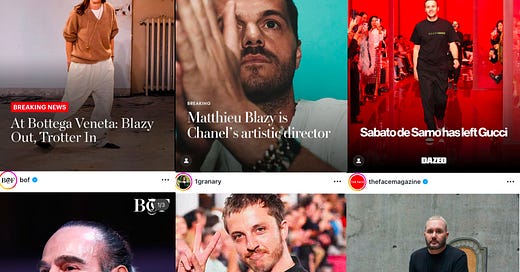The Revolving Door of Creative Directors: Can luxury fashion break out of this high turnover cycle?
Or, has luxury fashion become permanently trapped in the hype machine?
Lately, I can’t scroll through Instagram without seeing another headline about a luxury house switching creative directors—again. My inbox is flooded with articles from every major fashion publication, each trying to keep up with the industry’s latest game of musical chairs. No brand seems immune, and the pace is only accelerating.
Erin’s Edits on Substack recently wrote a great breakdown of all these changes, offering insight from her background in wholesale buying. If you’re struggling to keep up with the endless creative director shake-ups (like we all are), I recommend checking out her piece.
It’s confusing. But it also made me stop and think.
Having been a part of design teams and led design teams myself, I know how much instability at the top shakes up not just one person’s career but an entire ecosystem of creatives. Once upon a time, creative directors had years—sometimes decades—to define a brand’s identity, evolve its DNA, and build something lasting. Now? It’s a high-stakes, short-term gig where you’re expected to deliver instant magic.
And let’s be real: that pressure doesn’t come from nowhere. The industry is hooked on media buzz, social virality, and financial returns that demand immediate impact. One lukewarm collection, and whispers of a replacement start circulating. A couple of seasons that don’t hit? You’re out.
But here’s the question: does this cycle benefit anyone? Did the industry let this happen intentionally? Or is it simply a result of chasing short-term wins at the cost of long-term vision?
The Problem: Instant Judgment, Instant Replacement
Fashion has become obsessed with the star creative director—placing immense pressure on a single individual to carry the entire brand’s legacy, sales, and cultural relevance.
A few seasons in, if a designer hasn’t produced an industry-defining hit, the countdown to their exit begins. There’s barely time to establish a vision, let alone evolve it. And while we can blame impatient executives or relentless investors, the truth is, we—the media, the consumers—are all part of the problem. Social media’s instant feedback loop means that within minutes of a collection debuting, verdicts are out: Genius! Boring. Fire them. Next.
It’s all reaction, no patience. And it’s creating a churn-and-burn cycle that leaves no room for genuine brand evolution.
The Business Perspective: Why Are Brands So Impatient?
From the outside, it’s easy to ask: Why don’t brands just give designers more time? But from a business standpoint, luxury fashion isn’t just about artistry anymore—it’s about keeping shareholders happy. When success is measured in immediate numbers (sales, engagement, media hype), patience becomes a luxury most brands can’t afford.
Here’s what executives are really thinking:
1. “We need immediate ROI (Return on Investment).”
Investors expect quarterly growth. Waiting a few seasons for a designer to “find their footing” feels impossible.
2. “Bad press = bad sales.”
A few mediocre reviews can turn off customers and retailers.
In the age of hyper-reactive consumers, brand loyalty is fragile. Social media backlash spreads fast, making a slow creative build-up almost impossible.
3. “We have to keep up with competitors.”
If one brand makes a flashy CD change and gets immediate media attention, others fear looking “stale” by standing still.
The race for cultural relevance is so fast that brands are afraid to commit to long-term vision.
The Bigger Risk: How This Hurts the Industry
In the short term, the brand and investors may chase quick ROI(return on investment), driving rapid creative director turnovers.
But in doing so, they are inadvertently training consumers to move fluidly between brands, cherry-picking whichever house is most talked about or going viral among the fashion crowd. The result? Brand loyalty weakens, and consumers become less emotionally invested in any single fashion house.
This shift is a long-term risk. If customers no longer feel deeply connected to a brand’s heritage, story, or aesthetic—because it keeps changing—they have no reason to stay loyal. Instead, they chase trends, reducing long-term customer retention and diminishing the value of brand legacy. Ultimately, the brands and the industry as a whole stand to lose the most.
Is There a Way Out?
So, can luxury fashion break out of this cycle? There’s no easy fix, but some things need to change. It’s a systemic issue, and even if one brand wanted to break the cycle, they’d risk losing market share if the rest of the industry keeps playing the same game. In my opinion, the only way out requires a group effort across executives, designers, media, and consumers.
From a Brand Perspective
Longer Contracts & Structured Growth Periods: Brands need to stop treating CDs as disposable assets. Establish structured three-to-five-year growth plans with clear milestones rather than reacting season by season. Instead of focusing solely on quarterly sales, brands should measure long-term cultural impact, craftsmanship, and creative innovation.
Build brand identity beyond the CD: The obsession with celebrity designers has made fashion feel like entertainment rather than craftsmanship. Maybe it’s time for brands to transition into a more collaborative and understated creative leadership model. Think Hermès—its DNA is so strong that no single designer defines the brand. Hermès may not be the hottest, most buzzworthy name each season, but it has built and maintained its value and integrity at the highest level. Isn’t that what luxury is meant to be—timeless, investment-worthy, and enduring in value?
Make it about the work of the house, not a single creative lead: Here,
recently published an interesting article titled “Why Don’t Brands Ever Spotlight the In-House Designers?” The article highlights how little we know about the senior team members shaping most labels:
“The cult of the creative director is so prevalent that many houses would genuinely have you believe that one person designs every single outfit in a collection, that the whole brand is resting on the shoulders of a single brain. This is very obviously not true.
Shifting focus from a single celebrity CD to a strong internal design culture can help distribute creative responsibility, reduce pressure on one individual, and ensure continuity within a brand. When a CD leaves, the house shouldn’t feel like it’s starting from scratch. Strong internal succession planning ensures stability rather than scrambling for the next “it” designer.
Protect creative teams: Quick turnovers don’t just hurt the CD—they burn out entire teams. Constant leadership changes force creative teams to continuously pivot, losing momentum, motivation, and the ability to develop a cohesive design language. This instability weakens a brand’s foundation, making it harder to maintain consistency and long-term innovation. Investing in continuity and internal talent retention is key to sustaining a strong creative core.
Co-Creative Leadership: Implementing a dual leadership system—where visionary responsibilities are shared—could also help lift some pressure off a single individual while fostering a more balanced and brand-driven approach. This system ensures that creative leadership remains stable even as individual designers come and go.
Educate consumers: If brands actively communicate the evolution of a brand’s vision, customers might be more willing to trust the long-term process rather than expecting instant transformation. Right now, the trend of brands disposing of creative directors after just a few seasons of mediocre collections is making consumers even more hesitant to spend. Many don’t want to invest in products from a designer era that feels 'soon-to-be-disposed,' further destabilizing brand loyalty and long-term revenue. Shifting consumer perception towards patience and investment in brand storytelling could help rebuild trust and commitment.
From a Media & Social Media Perspective
Reshaping Criticism & Expectations: Most importantly, the fashion media and influencers need to rethink how they judge new CDs. Instead of rushing to critique after one or two collections, why not assess over multiple seasons? This isn’t a reality show—it’s an industry built on legacy, craft, and storytelling.
Can We Actually Change This?
That’s the challenge. We’re already deep into a system where instant feedback, investor pressure, and viral media moments drive decision-making. But if brands, designers, media, and consumers all take steps toward valuing long-term creative vision over short-term hype, there’s a chance for change.
For now, though, it seems like the revolving door is spinning faster than ever.
So, What do you think? Can we break free from this cycle, or has luxury fashion become permanently trapped in the hype machine?








This article hits a nerve! The revolving door of creative directors is a real problem. The pressure cooker environment of constant deadlines and expectation for groundbreaking ideas is unsustainable. It's not just about individual burnout; companies need to foster cultures that truly value and support creativity, not just demand it. Offering flexibility, promoting a healthy work-life balance, and empowering creatives with autonomy are crucial. Ultimately, investing in a long-term vision and fostering a genuine creative environment will be more beneficial than chasing short-term trends with a constantly changing leadership team. Ignoring the well-being of creative directors is ultimately detrimental to the company's success and brand identity.